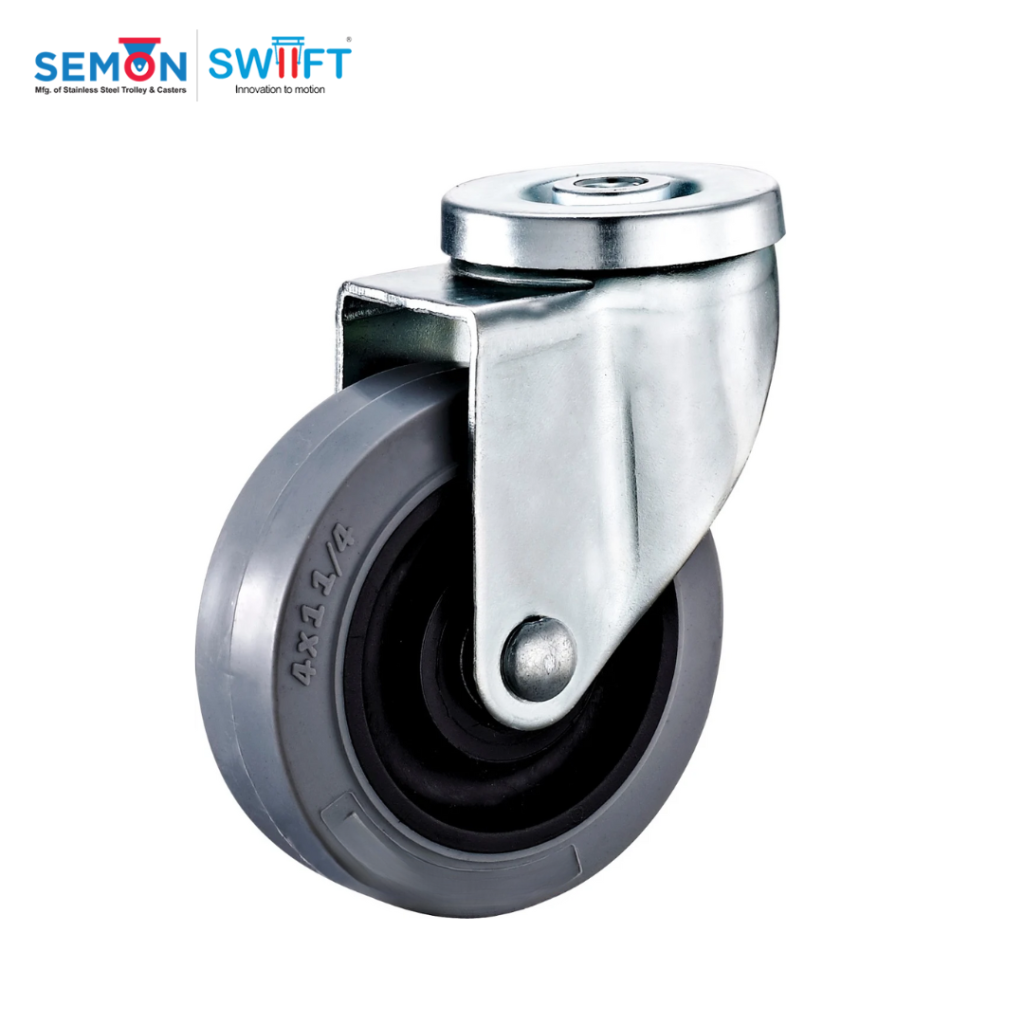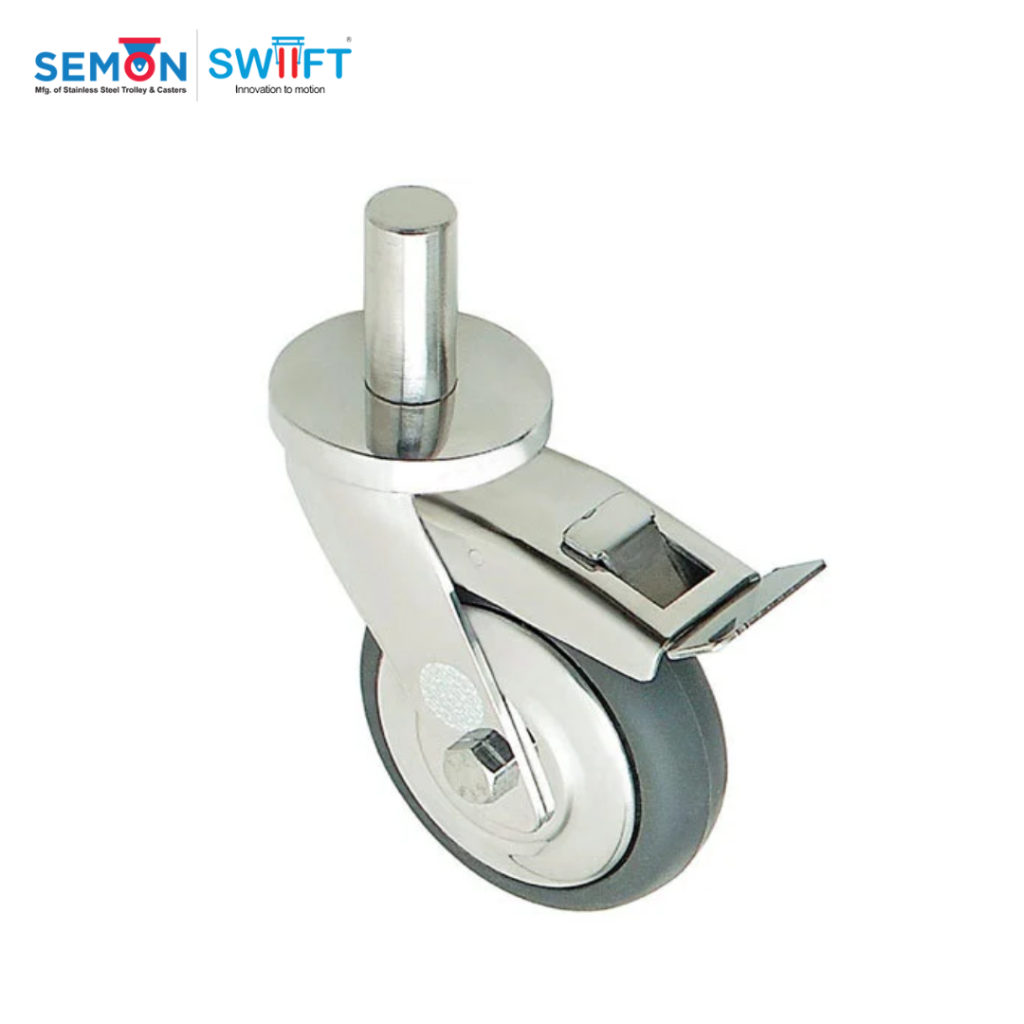Table of Contents
Antistatic wheels, prominently featured in Swiift Engg Industries’ product range, are a technological innovation designed to mitigate static electricity hazards. These wheels, also known as anti static caster wheels and anti static rollers, are vital in environments where static electricity can cause significant disruptions or dangers. The Importance of Antistatic Wheels in Medical Industries cannot be overstated, as they ensure the safe and efficient movement of medical equipment, reducing the risks associated with static electricity buildup. In essence, antistatic wheels are not just wheels; they are a crucial safety component in sensitive environments, making them an indispensable asset for modern medical facilities. Their unique design and material composition allow them to effectively dissipate static charges, thereby safeguarding both equipment and personnel.

The Importance of Antistatic Wheels in Medical Industries
The Importance of Antistatic Wheels in Medical Industries cannot be overstated, particularly in terms of making sure that equipment is moved safely. Antistatic wheels are essential in hospitals and clinics to prevent static electricity risks that can occur from using different medical devices. These anti-static caster wheels and anti-static rollers are essential for both enabling equipment to move smoothly and effectively and for drastically lowering the risks related to static electricity. In medical settings, where even little electrical disruptions can harm delicate medical equipment or jeopardise human safety, this decrease in static dangers is crucial. As a result, antistatic wheels are an essential safety feature in contemporary healthcare facilities, not just a component.
Antistatic Solutions in the Semiconductor Industry.
Static electricity regulation carries extremely high stakes in the semiconductor manufacturing industry. It is at this point that antistatic wheels become quite important. The “Importance of Antistatic Wheels in Medical Industries” is similarly important here since the semiconductor sector uses components that are extremely sensitive to electrostatic discharges (ESD). The sensitive semiconductor components are shielded from the potentially harmful effects of static electricity in the manufacturing facilities by the use of antistatic rollers and caster wheels. The integrity and performance of the semiconductor products depend on these antistatic technologies, which are more than merely precautionary measures.
The necessity of minimizing Electrostatic Discharges (ESD) in semiconductor production cannot be overstated. Antistatic wheels play a pivotal role in achieving this goal. They are specifically designed to dissipate static charges safely, thereby safeguarding the intricate circuits and components involved in semiconductor manufacturing. The use of these specialized wheels is a testament to the industry’s commitment to quality and reliability. By incorporating antistatic wheels, semiconductor manufacturers can significantly reduce the risk of ESD, ensuring that the highly sensitive electronic components are produced in a safe and controlled environment. This not only enhances the quality of the end products but also boosts the efficiency and safety of the manufacturing process.
Types of Antistatic Wheels
Rubber-Based Antistatic Wheels
In the realm of antistatic wheels, rubber-based options stand out for their affordability and versatility. These anti static rollers are particularly beneficial in the medical industry, where they offer essential resistance to static build-up. Their ability to operate quietly is an added advantage in healthcare settings that demand a noise-minimal environment. However, it’s worth noting that while rubber-based antistatic wheels are efficient in static control, they might not be the ideal choice for handling extremely heavy loads.

Metal-Based Antistatic Wheels
For scenarios demanding robustness and heavy-duty performance, metal-based antistatic wheels are the top contenders. These wheels, often made from specialized alloys, excel not only in resisting wear and tear but also in effectively dispersing static electricity. This makes them an excellent fit for industrial applications, including those in the medical industry, where durability and static control are critical. Their ability to handle heavier loads makes them a reliable choice for moving heavy medical equipment.

Composite Material-Based Antistatic Wheels
Composite material-based antistatic wheels present a hybrid solution, merging the strengths of both rubber and metal wheels. These anti static caster wheels are designed to offer high durability, substantial load capacity, and proficient static electricity dispersion. This combination is especially valuable in sensitive environments like medical facilities, where both the Importance of Antistatic Wheels and the need for robust, static-safe mobility solutions are paramount. They cater to the specific demands of medical equipment, ensuring safety and efficiency in operations where both heavy-duty performance and static control are essential.

Comparing Antistatic Wheels with Traditional Wheels
The comparison between antistatic wheels and traditional wheels is significant, especially considering the Importance of Antistatic Wheels in Medical Industries. Antistatic wheels, including anti static caster wheels and anti static rollers, are engineered with specific materials that prevent the accumulation of static electricity. Traditional wheels, on the other hand, are typically made from standard materials like rubber or plastic, which may generate static electricity through friction. The materials used in antistatic wheels are often a blend of conductive or dissipative elements, which effectively neutralize static charges. This is a critical property in environments like medical facilities, where static electricity can interfere with sensitive equipment or pose safety hazards.
Antistatic wheels function noticeably better than regular wheels in sensitive areas, especially in medical settings. These wheels guarantee that equipment movement doesn’t produce dangerous static charges, which is important in locations where electronic medical instruments are used. Because traditional wheels don’t have these antistatic qualities, static energy can build up and cause malfunctions or safety hazards. The effectiveness of antistatic wheels lies not only in their resistance to normal wear and tear but also in how they contribute to a more secure and productive workplace. This emphasises how important these specialty wheels are to the medical field and how essential they are to maintaining the functionality and safety of medical equipment.
Manufacturing and Quality Standards for Antistatic Wheels
The manufacturing of antistatic wheels, crucial in the medical industry, involves specialized processes to ensure they meet the highest standards of quality and functionality. These processes typically include the integration of conductive materials into the wheel’s core design. Manufacturers of anti static caster wheels and anti static rollers employ advanced techniques to embed these materials uniformly, ensuring consistent antistatic properties across the wheel surface. This is particularly important in medical environments where the Importance of Antistatic Wheels is underscored by the need for reliability and precision. The production process also often involves rigorous testing to ensure the wheels can effectively dissipate static electricity without compromising their structural integrity or performance.

Quality Control and Compliance Standards
Quality control and adherence to compliance standards are paramount in the manufacturing of antistatic wheels for the medical industry. Manufacturers must comply with a range of industry-specific standards and regulations, which often include stringent testing for electrostatic discharge (ESD) capabilities. This testing ensures that the antistatic wheels not only meet the basic functional requirements but also adhere to the safety and efficiency standards necessary in medical settings. Regular quality checks and certifications are integral to the production process, guaranteeing that each anti static caster wheel and anti static roller leaving the factory is capable of providing the necessary static control in sensitive medical environments. These rigorous quality standards reinforce the reliability and trustworthiness of antistatic wheels, making them an essential component in the medical industry.
Installation and Maintenance of Antistatic Wheels
Understanding the Correct Installation: Proper installation of antistatic wheels, such as anti static caster wheels and anti static rollers, is crucial, especially in the medical industry where they play a vital role. Ensure that the wheels are correctly aligned and securely fastened to the equipment. This not only guarantees their effectiveness but also prolongs their lifespan.
Routine Inspection for Wear and Damage: Regularly inspect the antistatic wheels for any signs of wear or damage. In medical settings, where the Importance of Antistatic Wheels is paramount, worn-out or damaged wheels can compromise the safety and functionality of the equipment.
Cleaning Procedures for Optimal Performance: Keep the wheels clean from dust and debris, as accumulation can hinder their antistatic properties. Use appropriate cleaning agents that do not interfere with the wheel’s ability to dissipate static electricity.
Checking for Static Dissipation Efficiency: Periodically test the wheels to ensure they are effectively dissipating static electricity. This is particularly important in medical environments where static charge can have serious implications.
Lubrication for Smooth Operation: To ensure efficient and smooth operation, lubricate the wheel axles and bearings as needed. But watch out that the lubricants you use don’t ruin the wheels’ antistatic qualities.
Replacement of Worn-Out Wheels: If the wheels exhibit noticeable wear or if their antistatic qualities start to wane, don’t wait to replace them. Antistatic wheels must perform properly in the medical industry for the equipment to be safe and efficient.
Respecting Manufacturer Instructions: When it comes to replacement, maintenance, and installation, always go by the manufacturer’s instructions. By doing this, you can be sure that the antistatic wheels are operating at their maximum efficiency and adhering to industry regulations.
Training Staff for Maintenance: Educate the staff responsible for maintenance on the proper care and handling of these specialized wheels. Knowledgeable maintenance can significantly extend the life and effectiveness of antistatic wheels in medical equipment.
Conclusion
The use of antistatic wheels, including the antistatic rollers and caster wheels provided by Swiift Engineering Industries, has revolutionised many industries, most notably the medical field. Due to their great reduction in the risk of static electricity, these wheels have completely changed the way equipment is handled in delicate conditions, addressing the importance of antistatic wheels in the medical industry. Their transformative significance is further highlighted by their longevity, operational efficiency, and safe dissipation of static charges. Antistatic wheel technology has a bright future ahead of it, with possible developments aiming at increasing their efficacy and suitability for use in a variety of industries. These cutting-edge wheels will become even more crucial as time goes on in maintaining efficiency and safety in demanding settings like semiconductor manufacturing and healthcare.
FAQs
Why are antistatic wheels crucial in the medical and semiconductor industries?
Antistatic wheels are essential in these industries due to their ability to reduce electrostatic discharge (ESD), which can be detrimental to sensitive equipment and environments, particularly where precision and cleanliness are paramount.
How do antistatic wheels differ from regular wheels?
Antistatic wheels are designed with materials that prevent the buildup of static electricity. Unlike regular wheels, they safely dissipate static charges, thereby reducing the risk of ESD which can damage sensitive electronic components or ignite flammable substances in medical environments.
Can antistatic wheels be retrofitted onto existing equipment?
Yes, antistatic wheels can often be retrofitted onto existing equipment. However, it’s important to ensure compatibility and correct installation for them to function effectively.
Are there specific maintenance requirements for antistatic wheels?
While maintenance requirements may vary depending on the type and usage, regular cleaning to remove dirt and debris that might hinder their antistatic properties is generally recommended. Additionally, periodic checks for wear and tear are important to maintain their effectiveness.
How do advancements in antistatic wheel technology impact these industries?
Advancements in antistatic technology lead to more efficient and reliable wheels, which can handle higher loads, offer better durability, and provide enhanced safety. These improvements are crucial in industries where even a minor static discharge can have significant consequences.

